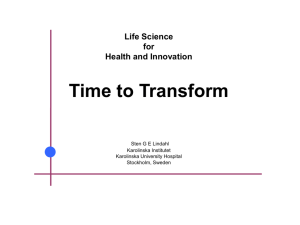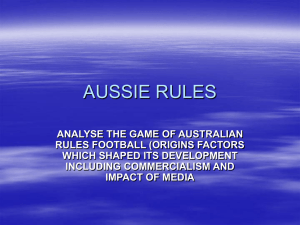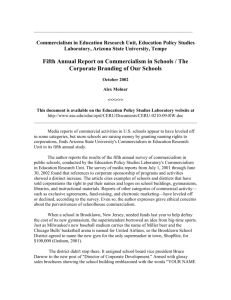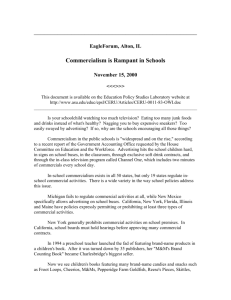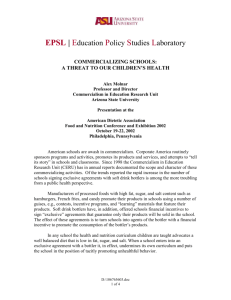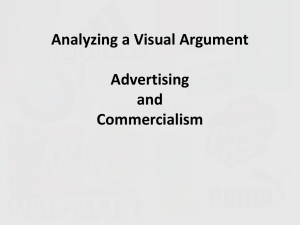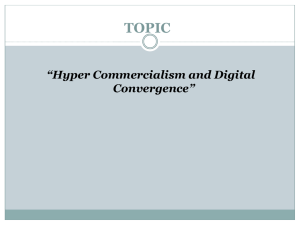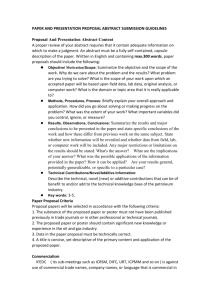Executive Summary for - National Education Policy Center
advertisement
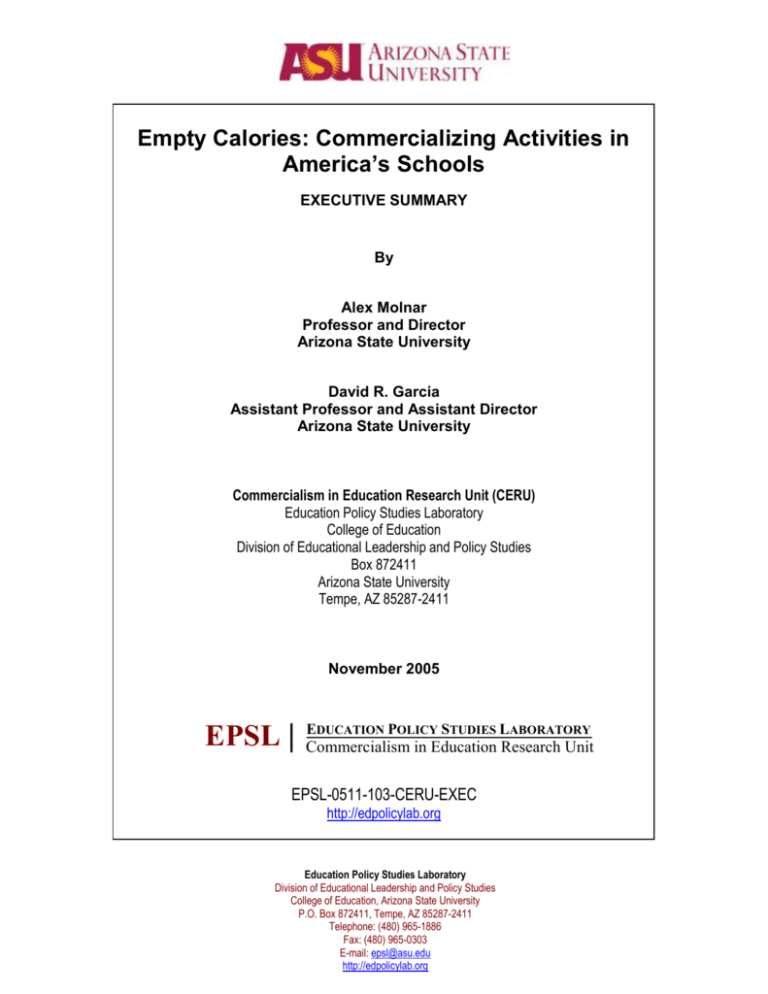
Empty Calories: Commercializing Activities in America’s Schools EXECUTIVE SUMMARY By Alex Molnar Professor and Director Arizona State University David R. Garcia Assistant Professor and Assistant Director Arizona State University Commercialism in Education Research Unit (CERU) Education Policy Studies Laboratory College of Education Division of Educational Leadership and Policy Studies Box 872411 Arizona State University Tempe, AZ 85287-2411 November 2005 EPSL | EDUCATION POLICY STUDIES LABORATORY Commercialism in Education Research Unit EPSL-0511-103-CERU-EXEC http://edpolicylab.org Education Policy Studies Laboratory Division of Educational Leadership and Policy Studies College of Education, Arizona State University P.O. Box 872411, Tempe, AZ 85287-2411 Telephone: (480) 965-1886 Fax: (480) 965-0303 E-mail: epsl@asu.edu http://edpolicylab.org Empty Calories: Commercializing Activities in America’s Schools Alex Molnar Professor and Director Education Policy Studies Laboratory Arizona State University David R. Garcia Assistant Professor and Assistant Director Education Policy Studies Laboratory Arizona State University Executive Summary This year’s Schoolhouse Commercialism Trends report finds that schools continue to be a prime target of a wide variety of corporate advertising efforts and criticism of marketing to children in schools is mounting. Most of this criticism is directed at marketing activities that are thought to have a negative impact on children’s health. Public debate has led to government regulation and bans of commercial activity in some school districts; however, commercial interests show few serious signs of pulling back. From July 1, 2004 to June 30, 2005, the Education Policy Studies Laboratory’s Commercialism in Education Research Unit at Arizona State University conducted media database searches in Education Index, Google News and Lexis-Nexis, and recorded a total of 5,929 media references related to schoolhouse commercialism. These references were grouped into eight categories and two supplementary searches (new to this year’s report), each of which is listed below and followed by its definition: Corporate Sponsorship of Programs and Activities: Corporations paying for or subsidizing school events or one-time activities in return for the right to associate their name with the events and activities. For example, NBC, Campbell’s Soup, and Scholastic teamed up to promote NBC’s dramatic series “American Dreams” by sponsoring an essay contest—with a $100,000 scholarship as first prize—for high school students. Exclusive Agreements: Agreements between schools and corporations that give corporations the exclusive right to sell and promote their goods or services in the school district—for example, exclusive pouring rights for Pepsi-Cola or Coca-Cola. Incentive Programs: Corporate programs that provide money, goods, or services to a student, school, or school district when its students, parents, or staff engage in a specified activity—for example, Pizza Hut’s “Book It” program. Appropriation of Space: The allocation of school space such as scoreboards, rooftops, bulletin boards, walls, and textbooks on which corporations may place corporate logos or advertising messages for a wide range of products, including soft drinks and snack foods. Sponsored Education Materials: Materials supplied by corporations or trade associations that claim to have an instructional content, such as Starbucks Coffee’s “Ask, Listen, Learn: Kids and Alcohol Don’t Mix.” Electronic Marketing: The provision of electronic programming, equipment, or both in return for the right to advertise to students or their Page 2 of 5 families and community members in the school or when they contact the school or district. The most dominant example is Channel One which furnishes television equipment to schools in return for a requirement that students watch a 12-minute news program, including two minutes of commercials. Privatization: Management of public schools or school programs by private, for-profit corporations or other non-public entities. For example, K12, Inc. manages virtual schools under state charter schooling laws and enrolls students who take online classes from home. Fundraising: Commercial programs marketed to schools to raise funds for school programs and activities, including door-to-door sales, affinity marketing programs, and similar ventures. For example, Schoolpop Inc. Schoolpop markets technology in partnership with corporations to administer “Scrip” programs that encourage parents to shop at designated stores in return for a donation back to the school Children’s Health (supplementary search): Issues that address the nutritional value of school food offerings and regulations that aim to improve the health of students by regulating what foods can be offered in the cafeterias, canteens, and vending machines. Commercialism (supplementary search): Issues about commercialism in schools that do not qualify for the more specific categories of the report, including references to legislation regulating commercialism in schools and scholarly articles collected from the education press. Page 3 of 5 2004-2005 is in a transition year with regard to methodology. Changes in the methodology and the addition of two supplementary searches make it impossible to accurately establish trends within a particular category of commercialism. With regard to overall trends, however, the 2004-2005 findings suggest that the overall number of citations is about the same as the total recorded in the 2003-2004 period. The 2004-2005 references reflect a far more pervasive context of criticism and debate over schoolhouse commercialism, particularly with regard to commercialism practices that are perceived to have an impact on children’s health. Efforts to rein in these practices were most visible in the area of exclusive contracts (mostly vending contracts). It is clear that there is growing concern over childhood obesity and the role that schoolhouse commercialism may play in its increase. The impact of government regulation is powerful; however, despite the restrictive regulations or in some instances outright bans on schools selling soft drinks or junk food, some schools and districts continue to sign new exclusive contracts with soft-drink and snack vendors. A relatively new phenomenon that helps to promote commercialism in schools is the role played by the No Child Left Behind Act of 2001 (NCLB). The increasing emphasis on test scores as measures of achievement and on numerical accountability measures has created a context in which incentive programs may be particularly enticing for schools seeking to boost those test scores. NCLB’s consideration of attendance rates also has led to attendance-incentive programs in some schools. Instances of overheated rhetoric and deep-pockets lobbying illustrate how controversial advertising in schools has become. As a result, those who benefit from it are fighting harder than ever to retain their access to the nation’s schoolchildren. The Page 4 of 5 choice is increasingly stark for school leaders, who will have to decide whether their jobs entail providing an education to their students or offering them up as “untapped points of entry” to marketers. Page 5 of 5

